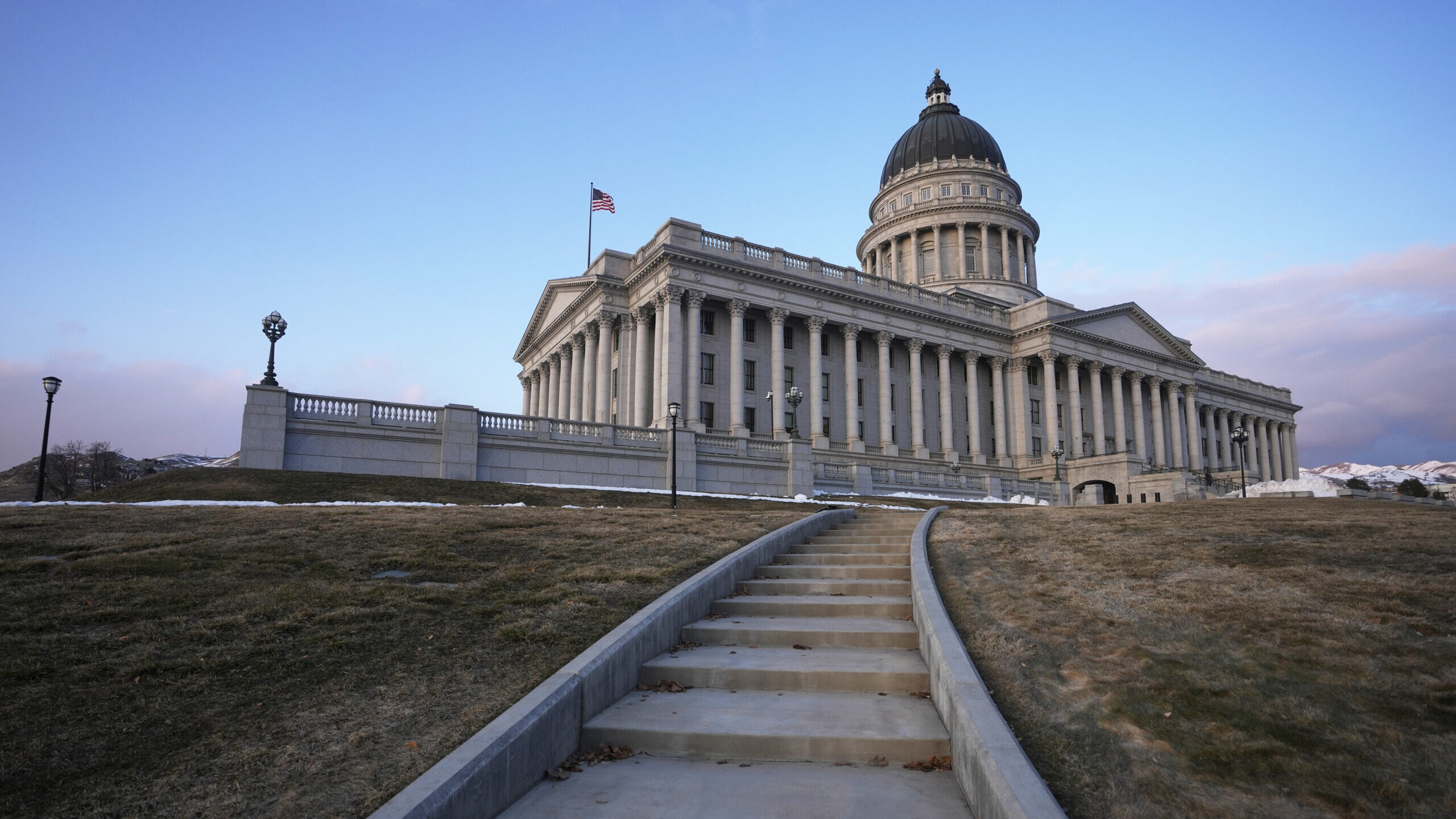UTAH
Yes, data centers use a lot of water, but a Utah company shows it doesn’t have to be that way
Jul 18, 2022, 11:30 AM

FILE: Paddleboarders leave the water at the Great Salt Lake State Park in Salt Lake City on Friday, June 10, 2022. On Friday, it was announced that Congress is sending $10 million to Utah specifically to help the Great Salt Lake. The money is coming from the $858 billion defense bill. Photo credit: Laura Seitz/Deseret News.
This article is published through the Great Salt Lake Collaborative, a solutions journalism initiative that partners news, education, and media organizations to help inform people about the plight of the Great Salt Lake.
WEST JORDAN, Utah — Novva’s new Utah data center looks like it could double as the set of a high-tech Hollywood thriller.
It has sleek modern architecture with high-end finishes. An observation deck with frosted smart glass turns transparent with just a touch. It reveals banks of servers, row upon row, humming away day and night. Clients access those servers via stiff security, including facial scanners, heat signatures and laser detectors. A pack of robotic guard “dogs” (programmed by Brigham Young University students) patrol dozens of miles each day across the server farm, searching for would-be trespassers and thieves.
“It’s just as difficult to get out of here as it is to get in,” said Novva CEO Wes Swenson, snappily dressed in black from head to toe, hints of the Payson drawl of his youth occasionally peeking through as he speaks.
Beyond all the gadgets, Novva offers one innovation that should at least pique the curiosity of Utah’s drought-stricken communities: Compared to most massive data centers around the state and the world, Novva uses a fraction of the water.
There are those who might shrug off the center’s technology, like security drones so finely tuned they can detect vibrations that aren’t due to wind. Or those who turn up their nose at more data centers along the Wasatch Front, given the amount of land they consume and other environmental concerns. But with the rise of the internet, the surge of streaming, an influx of smart devices and a future of autonomous vehicles, big server farms are increasingly a mainstay of life.
“The fact is,” Swenson said, “unless people want to put down their computers, you’re going to have to have data centers.”
And if we have to have them, at least they could help offer a solution to northern Utah’s water-strapped cities, and potentially let more trickle downstream to the shriveling Great Salt Lake.
Data centers’ water needs
Asked whether his facility could serve as a backdrop for the next James Bond flick, Swenson gave a tacit chuckle. But there’s a reason data centers like his are designed with cutting-edge technology.
“It’s the world’s most expensive insurance,” Swenson said of his campus, which eventually will represent a projected $1 billion investment. “You’re basically guaranteeing we will stay up, no matter what.”
That means its arsenal of servers can’t overheat.
The United States accounts for about 40% of the world’s large cloud and internet data sites. Utah is home to at least 25 “colocation” data centers, according to a Data Center Map estimate, most of them near Salt Lake City. Those sites, like Novva, rent servers to a variety of customers, from gas stations to medical companies. The figure doesn’t include big centers run by single entities, like the U.S. National Security Agency’s operation in Bluffdale or Facebook’s facility in Eagle Mountain.
And most data centers, regardless of their operators, rely on evaporative cooling to keep their servers at optimal temperatures. Some gulp down millions of gallons each month.
“It’s a worse story than you can imagine,” Swenson said. “They’re using culinary water, not irrigation [water], so it’s been treated by the city. … It’s a complete waste of a resource.”
Data centers further treat their water with chemicals to prevent things like scale buildup and Legionnaires’ disease. Some of the water is lost through the evaporative process, while the rest can be reused only a few times before it has to be flushed from the system.
Unfortunately, Swenson said, “the places where evaporative cooling works the best are the places where there is the least amount of water.”
As climate change fuels drier conditions and the West’s current “megadrought” shows no signs of ending, some of those arid communities are protesting water-guzzling data facilities. In the early 2010s, Utahns worried so much about the NSA data center’s water consumption — along with Edward Snowden’s revelations that the agency was illegally spying on U.S. citizens — that a Republican legislator proposed shutting off its supply.
In 2020, Google found itself in a legal battle with a utility provider in Red Oak, Texas, which insisted it didn’t have enough water to meet the company’s 1.5 billion-gallon annual need. And last year, the vice mayor of Mesa, Ariz., called data centers an “irresponsible” use of water.
So how much water do data centers use?
The essential difference with the Novva data center is that it cycles refrigerant instead of relying on water evaporation. Swenson incorporated a similar system as the CEO of the 97,000-square-foot C7 data center in Bluffdale, designed for 10 megawatts. That facilitysold to DataBank in 2017, but Swenson said he learned a lot from the project.
“We’ve gotten way better at it,” he said. “And the systems we’ve adapted for this are really something we’ve done. It’s not an off-the-shelf product.”
Comparing those water-light facilities with two of Utah’s largest data centers — Facebook and NSA — reveals conspicuously different use patterns.
The NSA facility in Bluffdale is 1 million square feet, with 100,000 square feet dedicated to its Tier III data center. It uses 65 megawatts.
In the 12 months between June 2021 and May of this year, NSA drained more than 128 million gallons, according to a records request sent to Bluffdale. Even with Utahns’ high water-consumption habits — the U.S. Geological Survey currently rates them as the second thirstiest users in the nation — that’s enough water to support nearly 2,100 residents.
If the state adopted stricter conservation measures like, say, Nevada, the NSA’s water could support almost 2,800 Utahns.
That might sound like a drop in a leaky bucket, considering Utah’s water woes. But with subdivisions multiplying along the Wasatch Front and the Great Salt Lake receding more and more by the day, every drip counts.
Facebook’s parent company, Meta, has adopted sustainability goals for its own data centers. Still, it consumed 13.5 million gallons in the year between June and May at its 970,000-square-foot Utah site, according to information provided by Eagle Mountain.
The C7/DataBank center in Bluffdale — which is a tenth the size of the NSA and Facebook campuses — used 6.9 million gallons in the past year.
Novva, meanwhile, has consumed about 1.1 million gallons since its servers went on line in January, according to West Jordan. In May, it used 585,000 gallons — its highest monthly rate of consumption to date. By comparison, Facebook used 1.3 million that month and the NSA chugged nearly 13 million gallons.
How Novva’s system works
Novva currently has 330,000 square feet of server space, designed to use up to 30 megawatts, and plans to expand to 1.5 million square feet. The center ultimately will have a 120-megawatt capacity, according to the Novva website, although Swenson said he could use as much as 200 megawatts.
If the fully built center used traditional evaporative cooling, Swenson noted, it would ingest around 300 million gallons a year.
Instead, the center will use water mostly to establish drought-tolerant, native vegetation around the campus (it also has artificial turf) for the next two years.
“After that, we cut it off, and everything is just naturally growing,” Swenson said. “So the only water we use is for [drinking], toilets, things like that. Just like a house.”
The Novva campus uses closed, recirculating pipes with refrigerant to cool its servers. It also capitalizes on Utah’s high-desert climate.
“The advantage of sitting at this altitude,” Swenson explained, “is that we use the outside air, just the ambient air temperature, to cool the center about 4,000 hours a year.”
Fans suck the servers’ hot air underground, below 5-foot insulated floors, then exchange it with outdoor air during cooler months, when temperatures are below 70 degrees.
The system has an initial upfront cost that’s higher than traditional evaporative cooling, Swenson said, but he expects a payback period of eight years due to water savings.
“Quite honestly, the cities and counties have not been punitive about it,” he said, when asked why more data centers don’t install similar systems. “… Water’s cheap.”
The CEO added that he’s concerned about water, having lived in drought-prone places his entire life. But water-free cooling also makes business sense, especially as some areas scramble while their water supplies dry up.
“I’m trying to reduce my dependencies, not increase them,” Swenson said. “So why create another dependency on a natural resource I can’t control?”
Why some say data centers are worth their weight in water
Beyond water consumption, data centers don’t create many jobs. They also eat up a lot of energy (more on that later). Still, the Utah cities that welcome the facilities say they offer a lot of benefits.
Bluffdale’s 20,000 water customers live on fairly large residential lots for an urban area, and the city has a wide secondary water system. It mostly buys water from the Jordan Valley Water Conservancy District.
Construction of the NSA site helped fund a 3 million-gallon culinary water tank — which helps the city during peak demand periods — and four miles of municipal pipe, according to City Manager Mark Reid. “The infrastructure that came to the city was fantastic.”
What’s more, the spent water NSA discharges irrigates the park at City Hall and a nearby subdivision.
“It’s really good water,” Reid said. “It does excellent on grass.”
Speaking of infrastructure, data centers don’t generate nearly the amount of traffic as some industries, including the mining activities that have traditionally occurred on the Salt Lake Valley’s west side. That means less wear and tear to roads. They also have their own fire and security systems, so they’re less of a burden on a city’s firefighting and police budgets.
And, Reid pointed out, the NSA isn’t using anywhere near the 1.7 million gallons per day it initially projected.
In a statement, an NSA spokesperson said the agency is working to limit water use and be a responsible member of the community.
“For example,” the spokesperson said, “during the June 2021 through May 2022 time period, the NSA, through its efficiency efforts, returned more than 34.5 million gallons of water (or approximately 27% of its water estimate needs) to Bluffdale during the summer, or returned to the Jordan River during the winter.”
The agency is also working to reduce its water needs by using “dry coolers” instead of evaporative systems.
At Eagle Mountain, City Manager Paul Jerome said the Facebook data center provided something the growing Utah County city of more than 50,000 desperately needed — tax revenue.
“It’s a bedroom community. It probably will be for a long time,” Jerome said. “We don’t have the pass-through other cities have. We have far less retail than a city our size should have.”
The city west of Utah Lake is also planning for a new Google data center on 300 acres. Facebook, meanwhile, expects to more than double its center, to 2.4 million square feet.
Eagle Mountain recently raised its water rates for the first time in two decades. Facebook is locked in at the highest tier — $1.24 per 1,000 gallons — regardless of its consumption. The city mostly relies on groundwater but has increasingly turned to the Central Utah Water Conservancy District to supplement its supply.
Still, Jerome said, he’s not worried about adding more data center capacity.
“Right now, to be honest, we have water for our needs,” he said. “… Yes, they use water. We know this. At least the big ones do. It seems from where I’m sitting that they don’t use as much as everybody thought they would use.”
Facebook also has made an effort to give back to the community, Jerome said. It recently partnered with Utah Valley University, for example, to build a stargazing park in Eagle Mountain.
The company has worked to offset its water impacts as well, paying the Central Utah Water Conservancy District to scale back hydropower production during the hottest months to improve fish habitat in the Provo River, according to a spokesperson for Meta.
“Their whole push is to help rehabilitate state water sources so they can help create value that offsets their use of water,” Jerome said. “At a minimum, they’re trying to be water neutral.”
What about data centers’ high energy demands?
Water improvements aside, data centers devour a lot of electricity. Novva is no exception. And the coal-fired power plants that supply much of the state’s energy are known water guzzlers, too.
Novva could add a solar farm to its 100-acre property instead, Swenson said, but that would gobble up a lot more land. A recently approved solar project in Connecticut will supply a similar megawatt load that Novva is targeting, but it sprawls across nearly 500 acres.
That’s why Swenson said he buys 100% renewable energy for the Novva center through Rocky Mountain Power, emphasizing the need to invest in green energy locally. Even if Novva were to find enough land to build its own solar farm, it wouldn’t provide any benefit to other energy consumers.
“Whereas, if we do it as a collective with the power companies or local communities,” Swenson said, “we’re pushing [renewables] for everybody, and eventually we’ll bring down the cost for everyone.”
The approach to the data center’s water and energy use, and even its weird robot dogs and super-sensitive drones, Swenson said, is all about creating a paradigm shift in the industry.
“Novva, the name, comes from Latin, meaning ‘new,’” he said. “And that’s the idea.”
Tell us about what’s working, what could work, and what problems you’d like to see solved when it comes to the shrinking Great Salt Lake.












